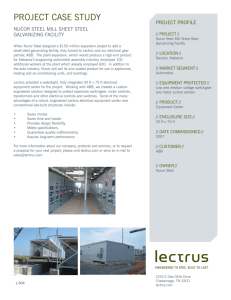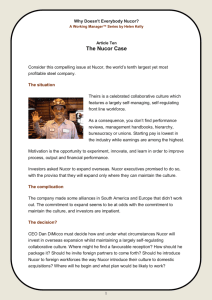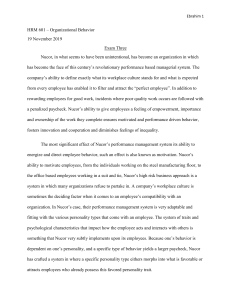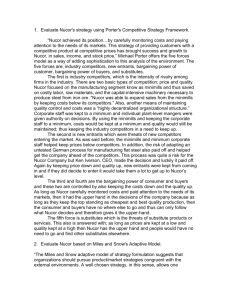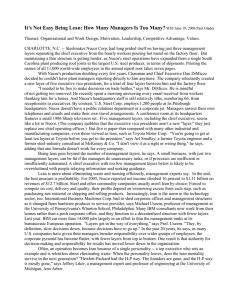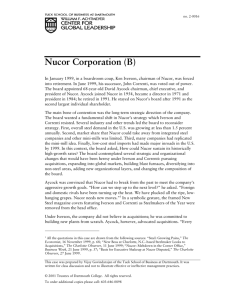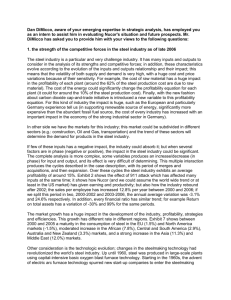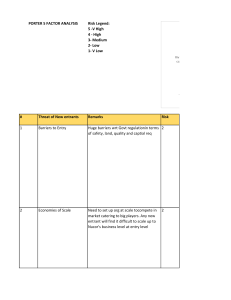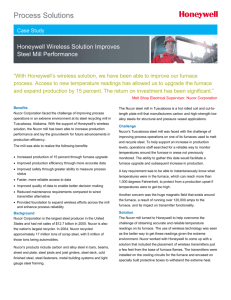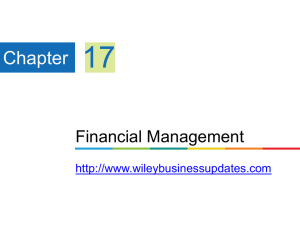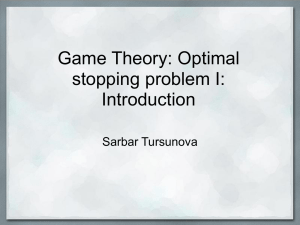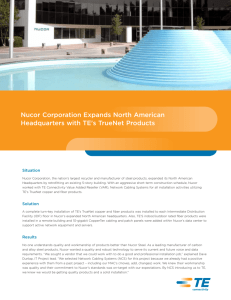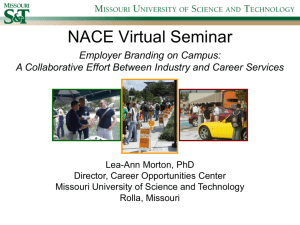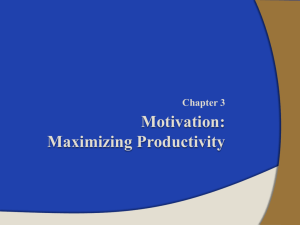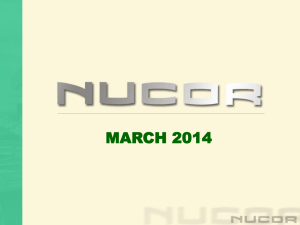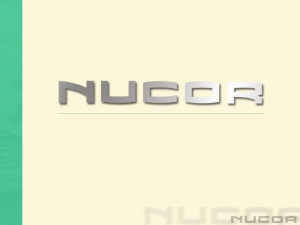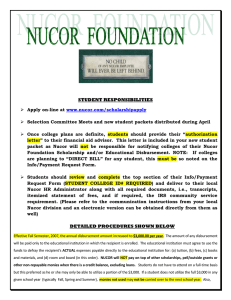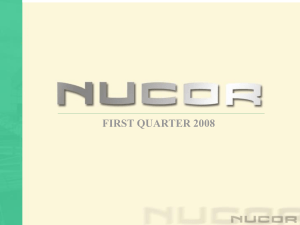Knowledge Management
advertisement
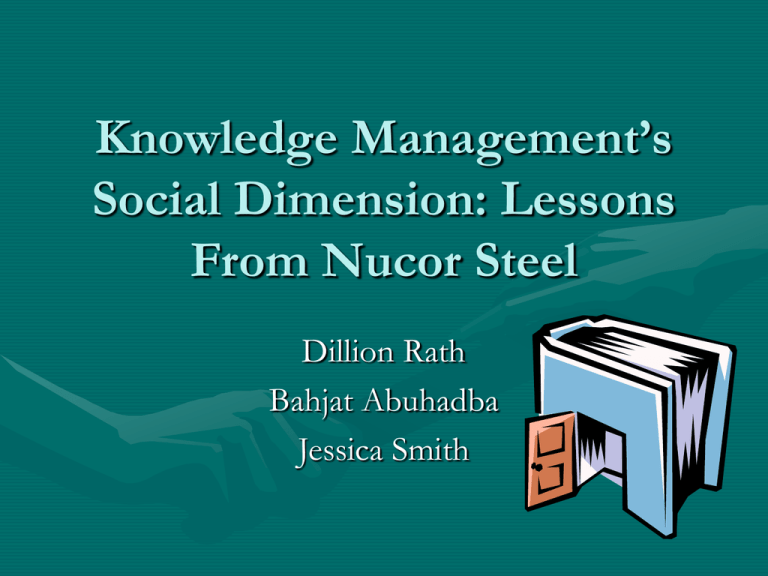
Knowledge Management’s Social Dimension: Lessons From Nucor Steel Dillion Rath Bahjat Abuhadba Jessica Smith Overview • • • • Social Ecology Information Technology Management Agenda The task of accumulating knowledge Social Ecology • Is the social environment within which people operate • Very crucial requirement for effective knowledge management • Defines the types of people who will fit into the organization • Shapes individuals freedom to pursue actions without prior approval • Affects how people interact with others inside and outside of the organization Information Technology • Are the programs that companies use to connect the entire number of employees together • Plays a central role in knowledge management • Is the only viable mechanism that efficiently connects large numbers of people together whether they are local or geographically dispensed Management Agenda • Is the process of keeping all information up to date and correct • Imperative to keep the company moving in a forward motion The task of accumulating knowledge • Can be broken down into three subtasks: • Knowledge creation (learning by doing) • Knowledge acquisition (internalizing external knowledge) • Knowledge retention (minimizing the loss of proprietary knowledge The Social Ecology of a Knowledge Machine: The Case of Nucor • Innovative and Fastest growing steel company for the past 30 years • Compound sales growth of 17% • 1968 to 1998 profit margins were above industry medians, and average annual return to shareholders exceeded 20% • Largest steel producers in the United States 1999 Knowledge Creation • Superior Human Capital – 1,200 applicants applied for 8 job openings in Darlington, South Carolina • High-powered Incentives – 1990’s payouts for production employees averaged 80% to 150% of base wages • High degree of empowerment – “Good managers make bad decisions” • Avg. - 50% good, 50% bad • Good – 60% good, 40% better How Nucor Accumulates Knowledge Knowledge Acquisition • First company to adopt minimill technology • 1987 - First to make flat-rolled steel in a minimill and to commercialize thin-slab casting Knowledge Retention • • • • No Layoff Policy Reduced the workweek “Share the pain” Response to recessions strengthen the spirit of trust and respect within the company • Lowest turnover rate of any company in its industry How Nucor Mobilizes and Shares Knowledge Identifying Opportunities to Share Knowledge • Made performance data available to the company • Allowed individual units and corporate headquarters to uncover opportunities to share best practices Encouraging Individuals to Share Knowledge • Share best practices proactively • Group based Incentive • Example: – Bonus depended not on their own performance, but on the performance of their entire 25-40 person work group Building Effective and Efficient Transmission Channels • IT used to transfer and share unstructured and codified knowledge – Intraplant Knowledge Transfers • 250 to 300 people in plant • Dinner for 25 to 100 employees each year Building Effective and Efficient Transmission Channels • Interplant Knowledge Transfers – Detailed performance data regularly distributed to plant managers – General managers met 3 times a year to review each facility’s performance and to develop formal plans for the transfer of best practices – Managers, supervisors, and machine operators periodically visited each others mills Building Effective and Efficient Transmission Channels – Selectively reassigned people from one plant to another on the basis of their expertise • Recycled process innovation form existing plants to start-up plants • Built and rebuilt one or more mills each year – Existing process knowledge was recycled into new plant-design and construction Building Effective and Efficient Transmission Channels – Natural Incentive because building plant for themselves – Knowledge of the underlying process technology embedded in the plant design was carried over in the workers’ mind from the construction phase to the operations phase – Plant start-up expertise emerged as a plant competency Convincing Individuals to Accept and Use the Knowledge they Receive • “Not invented here” – Relying on their own efforts at knowledge creation could be costly – Makes unit’s performance visible to other units in the company Knowledge Machine Company Divisions: 1. Creation and acquisition of knowledge 2. Sharing of knowledge • Nucor Corporation is a pioneer knowledge company. Maximizing knowledge Creation and Acquisitions: The above can achieved through: 1.Set Stretch Goals: Set goals that cannot be reached without innovation. Welch, “ If you do know how to get there it is not stretch target”. Basically, CEO of Yokogawa, “breaking out of the conventional”. Maximizing knowledge Creation and Acquisitions: 2. Provide High Powered Incentives: The higher the rewards the more likely employees will actively participate in the stretch-goal process. 3. Cultivate empowerment and provide “slack” level resources: In an innovative environment; limiting times of specific activities such as research and testing will stifle innovation. Example of innovation fostering, 3M requires at 15% of work time be done without supervision. Maximizing knowledge Creation and Acquisitions: 4. Equip every unit with a well defined sandbox to “Play”: Allow a determined percentage or revenue from the company for the sole purpose of experimentation. This will allow innovation yet under a controlled risk-assessing environment. Maximizing knowledge Creation and Acquisitions: 5.Cultivate a market for ideas within the company: Implementing reliable idea-screening mechanisms. No single individual should have the monopoly of wisdom thinking in the company. Maximizing Knowledge sharing: 1.Ban knowledge hoarding and turn knowledge givers into heroes: Decide which company product belongs to the whole business and which ones belong to single units. Rewards heroes who facilitate their adoption by other units of the business. Maximizing Knowledge sharing: 2. Rely on group based incentives: This helps direct efforts toward the general benefit rather than individual gain. It also exposes the purposely under-performers and takes corrective measures towards them. EX: Nucor, Group cash incentives, and Cisco, stock options (25.11) Approx Value. Maximizing Knowledge sharing: 3. Invest in Codification: Create a standard operating procedure. This will allow consistency of service and improve operations. Example, Marriot. 4. Matching knowledge mechanisms to the type of knowledge: Each piece of knowledge needs a different way to transmit it and share. Recreating Competitive Advantage • Intellectual capital along with the continuous desire for mobilizing new technology is the key toward staying on the completive edge. • In a global economy with opened competition; companies must adapt effective and sufficient knowledge development techniques to stay competitive.
